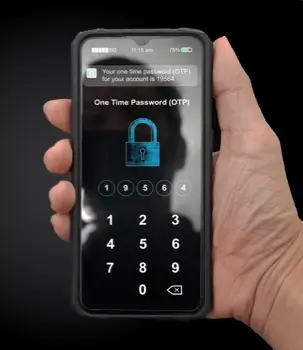The Importance of a One Time Password for Online Security
If you've ever been hacked, you know how challenging it is to restore your accounts and recover your information. Research shows that over 80% of today's data breaches happen due to subpar password security. That's where a one time password, or OTP, can help. In this article, explore what a one-time password is, how it works, and its importance for enhanced online security.
What is a one time password?
An OTP, short for one time password or one-time password, is an automatically generated password or code sent to your phone. It enables you to engage in a single transaction or login session. OTP codes are popular for enabling single logins to validate new accounts or confirm legitimate transactions, serving as an authentication method for users and accounts.
A benefit of one time password codes is that these numeric codes are unique and randomly produced by OTP generators, making them harder to guess. They add a robust security layer to each of your accounts.

When are OTPs used?
You may need to use an OTP to recover an online account for which you've forgotten your traditional password. Your online site will prompt you to click "Forgot Password" and create a new one.
The system will then verify your password creation attempt to ensure that you're the one requesting the change. It will do this by sending you an OTP to your phone or email to enter into the website so you can make the password change.
One time passwords vs. traditional passwords
Traditional passwords, also called static passwords, aren't enough to protect your sensitive data. A standalone password can't properly verify if you're attempting to access data or if a cyber thief is.
One-time passwords are the best types of passwords since they usually expire within minutes. This makes them more immune to password attacks than traditional passwords, which most users keep for several months or even years without changing them.
OTP verification uses secure technology to ensure that only authorized users can access accounts or data. This can help prevent your financial information from being stolen and your credit cards or bank account from being illegally used, leading to financial losses that may take days, weeks, or months to recover.
How do one-time passwords work?
An OTP is typically six digits or a combination of six letters and numbers. Authentication servers play an essential role in the OTP process. These applications verify the information users enter and send one time password messages to them.
These servers then verify the one-time passwords that users enter and authenticate their account logins or transactions. There are two types of one-time passwords you may receive: HOTPs and TOTPs.
HOTPs
A HOTP is a hash-based OTP. This is where an algorithm creates unique codes for multiple requests using counters. The code you receive through the HOTP method is valid until you request a different one.
HOTPs lack stringent time limits. You don't have to rush to use them within 10 minutes, making them easier to work with. However, these codes are less secure due to the lack of time limits.
TOTPs
Algorithms don't use incremental counters to generate TOTPs, or time-based one time passwords. These passwords use current timestamps instead, making them valid for only several minutes. This makes a TOTP more secure than a HOTP but less convenient, as you have to work quickly to get the code and enter it into the website or application.
How OTPs are sent to users
An OTP gets to a user's device in multiple ways, including Short Message Service (SMS) and voice messages. Other routes include email and push messages. Let's examine all of these password options for improved online safety.
SMS OTP
OTPs are most commonly sent through SMS, or text messages. That's because text messages are easy for individuals to access on their mobile phones.
Suppose you attempt an online account login or transaction. Your mobile phone then receives a one time password in a text if you previously linked your phone number to your online account. You'll enter this code online, and an authentication server will verify you.
A major benefit of OTP SMS services is that they don't require mobile phone users to be connected to the Internet. Mobile phone users can get a one-time password in seconds. Mobile phones usually require unlock codes, adding an extra security layer.
Voice OTP
Voice OTPs are unique, pre-recorded codes played over phone calls. You'll enter the code you hear in your voicemail message when logging onto an online account. A server will verify you and complete the user authentication process.
A voice one time password is particularly helpful for a user with sight challenges. It's also highly secure; your mobile phone does not store the password. This OTP delivery route is a handy alternative to OTP SMS.
Push OTP
This OTP option involves sending unique codes as push messages to users' apps. It doesn't require a cell phone signal, a data connection, or Internet access. Another benefit of push OTP is that you can receive a password only if logged into the relevant app, making it a secure OTP delivery method.
You can also use authenticator apps, like Google Authenticator, to add a second step of verification to your accounts. Two-factor authentication (2FA) uses one-time passwords to secure your accounts even on accounts that use traditional passwords.
Benefits of one time passwords
OTPs offer greater security
OTPs offer several benefits over traditional passwords, including that they're practically unhackable. That's because these passwords are simple but complex. These passwords are also extremely secure since they're unpredictable and not stored on computers.
Let's say a thief gains access to your one time password. The thief can't reuse it to log into your online account since an OTP only works for only one session. A new OTP is produced for every future transaction or login attempt.
Another reason to use OTPs is that a one-time password can help prevent an access breach even if a cyber attacker has found your login credentials. They may try to log into your account with your valid username and password information, but they won't get into it without the OTP the website sends to your phone.
This is a significant benefit given that many people reuse their traditional passwords across multiple sites to avoid recalling numerous passwords. Thieves that steal your credentials can easily use them to access more than one of your accounts, leading to fraud and stolen data on multiple fronts.
OTPs are highly reliable
An OTP sent through voice and SMS channels usually arrives within several minutes. You can request a second OTP if you don't receive a password on time. This makes one time passwords highly reliable and enhances the user experience.
OTPs are user-friendly
A one-time password is frequently used to complete tasks like activating bank cards, resetting online passwords as mentioned earlier, engaging in e-commerce, and approving documents. Most individuals own mobile phones, and text messages are available on them. The fact that SMS is common makes OTPs convenient.
Traditional password systems require users to create usernames and passwords and regularly change them. Changing passwords every three months is best. This prevents cybercriminals from remaining inside hacked accounts for extended periods if users' passwords are compromised.

OTPs eliminate the need to constantly change passwords since one-time passwords require only users' requests. This is another reason why they're more convenient.
One-time passwords also help decrease friction in your journey as a customer. Quickly gaining access to your account with a one-time password helps you more efficiently complete purchases or other transactions online.
Another benefit is that voice and SMS OTPs can go to mobile devices. This can help you avoid using a public computer with an unsecured wireless connection to log into an account.
Signs of an excellent one time password
The difficulty of one-time passwords depends on the sequences of characters used in them. An OTP with six characters is sufficient, but some OTPs have as many as ten characters. Six to ten is an ideal range since it strikes the perfect balance between resilience against a malicious attempt to guess a password and user convenience.
However, remember that a longer code is more secure. The strongest codes contain a mixture of lowercase and uppercase letters, special characters, and numbers. Popular special characters in a passcode include:
- Exclamation point (!)
- Ampersand (&)
- Pound sign (#)
- Question mark (?)
- Dollar sign ($)
- Equal sign (=)
- Plus sign (+)
- Greater-than sign (>)
- Lesser-than sign (<)
- At sign (@)
The best OTP service providers also make their OTPs easy to recognize. They emphasize an OTP's presence in a message when sending the password to an individual. They often do this by placing OTPs in messages' first lines or making the codes bold to capture users' attention.
If you have security concerns, consider using one-time passwords. They offer a secure way to log into an online account or engage in a transaction. Using a one-time password can help you avoid a data breach, a hacking incident, or a host of other online safety risks.